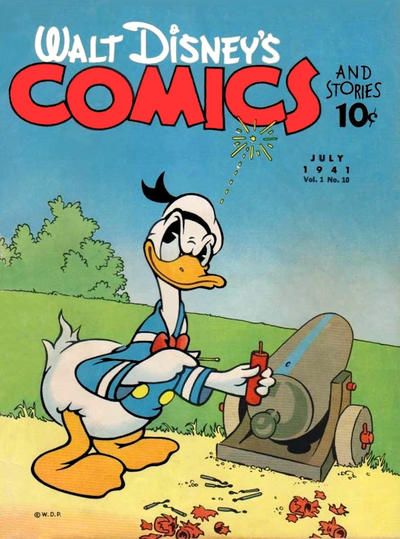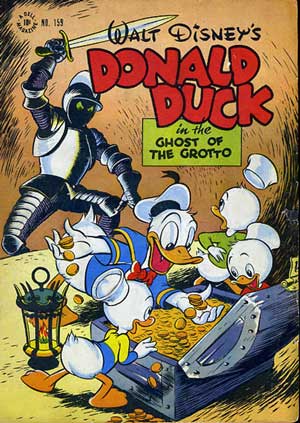Back in the Golden Age, Dell Comics was at the forefront of the comics industry when they launched FAMOUS FUNNIES in 1929. The comic is widely regarded as the very first American comic book to offer original content. And Dell was one of the most successful publishers in its near-half-century existence. So how did they get into comics, and what ultimately became of them?
Dell began in the late 1920s as a pulp magazine publisher, and even FAMOUS FUNNIES, launched in late 1929, was released in the popular tabloid format of the day, not in the smaller comic-book size that was adopted soon after (which makes some dispute its ranking as the first “comic book.” As you’ll see over and over, most comic book “firsts” are disputed by one party or another. Still, the facts remain that regardless of its larger size, FAMOUS FUNNIES did something no other publication did at the time, publish new comic-book content in a stapled format. Sounds like a comic book to us.).
The omnipresent Max Gaines helped package some of Dell’s next comic-book offerings, like POPULAR COMICS, a reprint of, er, popular newspaper strips like DICK TRACY and GASOLINE ALLEY.
Despite the prevalence of superhero comics in the late 1930s, Dell followed a different path. In ‘38, Dell changed its approach to comic-book publishing, choosing to now operate differently than other publishers. After going it alone for nearly a decade, the company decided to partner with Western Printing (a large publisher of licensed comics and children’s Golden Books, among other things). Western would produce and package comic books based on their licensed properties—most of which were aimed at a younger audience than other comics of the day—and Dell would foot the bill and distribute the comics, too.
One of Western’s largest licenses at the time was the Walt Disney stable of characters. Another was Warner Bros’ Looney Tunes characters. The company’s new titles, WALT DISNEY’S COMICS & STORIES and LOONEY TUNES & MERRY MELODIES COMICS, were huge hits with children.
The company followed up those efforts with comics based on Walter Lantz’s animated creations (Woody Woodpecker, Andy Panda, Chilly Willy and others) and even OUR GANG comics, featuring the Little Rascals.
Dell also launched FOUR COLOR COMICS, an anthology that tried out different characters as its lead story. This title too was very popular, and many of the characters featured in its pages—POPEYE and various Disney characters—spun off into their own books. FOUR COLOR was published as often as twice weekly for a time, and ran for an amazing 1,300 issues.
Dell’s arrangement with Western ended in the early ‘60s, when Western spun off their licensed characters into their own publishing line, Gold Key Comics.
Dell found itself at a crossroads. With so many of its popular licensed titles belonging to Western, the company decided to delve into creating original properties and licensed some properties of its own (although TV properties like BEWITCHED would never quite replace popular titles like the Disney and Merry Melodies titles).
The timing of all of this did not do Dell any favors. By the start of the ‘60s, the comic-book industry had stared down its greatest crisis and come out the other side as a superhero-dominated industry. Dell’s non-caped comics couldn’t find the same audience they once had, not when faced with DC’s popularity and the resurgent Marvel Comics. The company held on for another decade, surviving into the early ‘70s before finally realizing that they no longer had a place in this new, superheroic world
Licensed titles rarely receive the same respect in the comics industry as original creations. As a result, Dell’s preponderance of licensed titles, as well as its struggle to find a foothold in the last decade of its existence, has erroneously led many to dismiss the company’s importance in comparison to that of E.C. Comics, DC and Marvel. But the fact is, Dell is one of the cornerstones of this industry, and its impressive track record extends from its role in the formation of the comic book itself to a roster of some of the most acclaimed artists to ever put pencil to paper in the creation of a comic.
Carl Barks is not only the biggest name to ever work for Dell, he’s one of the best creators in the history of comics. He began his artistic career as an illustrator for Disney’s animated shorts before leaving the company to strike out on his own. Western hired him immediately to work on Donald Duck comics, and while Barks had aspirations to create his own characters, he instead took the feisty-but-unintelligible Donald Duck character and gave him a true personality, a family and an entire town in the pages of the comics. Barks’ comics were filled with such cleanliness of line, such sterling beauty, humor and heart that his funny animal comics had more resonance than most comics featuring human characters.
And Barks was just one of the artists who came to prominence working for Dell. Another former Disney animator, Walt Kelly (most well known as the creator of POGO) worked on Dell’s Disney titles, Our Gang comics, and so many more. Kelly was amazingly prolific during the years he spent working for Dell.
Russ Manning, the creator of MAGNUS ROBOT FIGHTER and namesake of a comic book award, was another who worked for Dell (and, later, on many titles for Gold Key as well). Alex Toth, an acclaimed comic-book artist and animator who worked for Hanna-Barbera, once worked for DC Comics and then was employed by Dell for a number of years. Dan Spiegle, a veteran cartoonist who spent decades working for DC Comics after working for Dell, and even the great John Buscema (best known for his work on Marvel’s SILVER SURFER, CONAN THE BARBARIAN and THE AVENGERS) both produced many pages for Dell, too. So if you come away from this with anything, it should be that Dell Publishing is one of the unsung champions of the early days of comic books.



Comments are closed.